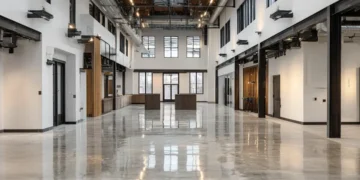
Preparing your home for a valuation is a critical step in the selling or refinancing process. A well-presented home can lead to a higher valuation, which in turn may help you secure a better sale price or more favorable refinancing terms. Here’s a detailed guide on how to prepare your home for a valuation.
1. Clean and Declutter
Tidy Up Every Room
- Deep Clean: A clean home creates a positive first impression. Deep clean your entire home, including carpets, windows, bathrooms, and kitchens. Pay special attention to areas that might get overlooked during regular cleaning, such as baseboards, light fixtures, and vents.
- Declutter: Remove any unnecessary items to make your home appear more spacious and organized. Clear surfaces, tidy up shelves, and store away personal belongings like photos and knick-knacks. A decluttered home feels larger and more welcoming, which can positively influence the valuer’s perception of your property.
Organize Storage Areas
- Tidy Closets and Cupboards: Storage space is an important consideration for buyers, so make sure your closets, cupboards, and other storage areas are neat and organized. When you are looking for “value my property” services, overstuffed or messy storage areas can give the impression of limited space thereby leading to incorrect valuation.
- Garage and Attic: Don’t forget to tidy up the garage, attic, or basement. These spaces can be valuable assets, so they should be clean and free of clutter to showcase their full potential.

2. Make Minor Repairs
Fix Visible Issues
- Repair Damages: Take care of any minor repairs before the valuation. This includes fixing leaky taps, patching holes in walls, repairing cracked tiles, and ensuring that doors and windows open and close properly. Even small issues can give the impression that the home has not been well-maintained.
- Address Cosmetic Issues: Consider touching up paint where needed, particularly in high-traffic areas or rooms with scuff marks. Repainting walls in neutral colours can also make spaces feel fresh and more universally appealing.
Update Fixtures and Fittings
- Replace Outdated Hardware: If your home has outdated fixtures, such as old doorknobs, light switches, or cabinet handles, consider replacing them with more modern options. These small updates can give your home a more contemporary look without a significant investment.
- Upgrade Lighting: Ensure that all lights are working and consider upgrading to energy-efficient LED bulbs. Good lighting can make rooms appear brighter and more inviting, which can positively impact the valuation.
3. Enhance Curb Appeal
Focus on the Exterior
- Maintain the Garden: The exterior of your home is the first thing the valuer will see, so make sure it looks well-maintained. Mow the lawn, trim hedges, weed flower beds, and add fresh mulch if needed. If you have a front garden, consider adding some colourful plants or flowers to enhance its appeal.
- Pressure Wash: Clean the exterior of your home, including driveways, walkways, and patios, using a pressure washer. Removing dirt, grime, and mildew can make your home look more attractive and well-cared-for.
Front Door and Entrance
- Paint or Replace the Front Door: The front door is a focal point of your home’s exterior. If it’s looking worn, consider painting or replacing it. A fresh coat of paint in a bold, welcoming colour can make a strong first impression.
- Enhance the Entryway: Add a new doormat, some potted plants, and ensure that the house number is clearly visible. These small touches can make the entrance more inviting and give a positive first impression.
4. Stage Your Home
Create a Welcoming Environment
- Arrange Furniture Thoughtfully: Arrange furniture to highlight the space and flow of each room. Avoid overcrowding rooms with too much furniture, and ensure that pathways are clear. Staging the furniture to show off the room’s potential can help the valuer see how the space can be used effectively.
- Neutral Decor: If possible, use neutral decor to appeal to a broader audience. Neutral tones create a blank canvas that allows the valuer to focus on the home’s features rather than personal taste in decor.
Add Finishing Touches
- Fresh Flowers and Plants: Adding fresh flowers or houseplants can bring life to a room and make it feel more homely. Place them in key areas such as the living room, dining table, or kitchen.
- Pleasant Scents: Ensure your home smells pleasant. Consider using air fresheners, scented candles, or baking something in the oven just before the valuation. Avoid strong odours that might be off-putting.

5. Highlight Unique Features
Showcase What Makes Your Home Special
- Point Out Upgrades: If you’ve made significant upgrades or renovations, such as a new kitchen, bathroom, or energy-efficient windows, make sure these are highlighted during the valuation. Provide documentation of the work completed, including warranties and receipts.
- Emphasize Space and Storage: If your home has ample storage, a large garage, a walk-in wardrobe, or a finished basement, ensure these features are showcased. These elements can add significant value to your home.
Prepare a List of Features
- Create a List: Prepare a list of key features and upgrades that you can provide to the valuer. This can include energy-efficient appliances, new roofing, recent renovations, or unique architectural details. Having this information ready shows that you’re organized and helps the valuer understand the full scope of what your home offers.
- Neighbourhood Highlights: If your home is located in a desirable neighbourhood with good schools, parks, or public transport links, mention these benefits to the valuer. The location can greatly influence the value of your property.
6. Ensure Easy Access and Be Presentable
Accessibility and Safety
- Clear Pathways: Ensure that the valuer can easily access all areas of the home, including attics, basements, and garages. Clear any obstacles that might prevent the valuer from thoroughly inspecting the property.
- Safety First: Ensure that your home is safe to navigate. Replace any faulty light bulbs, clear walkways of clutter, and ensure that stairways and handrails are secure.
Present Yourself and the Home
- Be Polite and Helpful: If you’re present during the valuation, be polite and helpful. Answer any questions the valuer may have, but avoid hovering or being overly intrusive. Provide any necessary information and then give the valuer space to do their job.
- Tidy Pets: If you have pets, ensure they are kept out of the way during the valuation. Not all valuers are comfortable around animals, and pets can sometimes be a distraction.

7. Provide Necessary Documentation
Documentation of Work Done
- Renovation Records: Provide records of any renovations or upgrades you’ve done, including dates, contractors used, and costs. This information helps the valuer accurately assess the value added by these improvements.
- Warranties and Guarantees: If any appliances, systems, or work done on the home come with warranties or guarantees, have these documents available. This can reassure the valuer that recent work is covered and that the home is well-maintained.
Property Information
- Floor Plans and Surveys: If you have a recent floor plan or survey of the property, provide it to the valuer. Accurate measurements and layouts can help the valuer assess the property more accurately.
- Utility Bills and Taxes: Have recent utility bills and property tax information available. This can give the valuer insight into the cost of living in the home and may be relevant for the valuation.
Finally, preparing your home for a valuation requires attention to detail and a focus on presenting your property in the best possible light. By cleaning, decluttering, making minor repairs, enhancing curb appeal, and showcasing your home’s unique features, you can help ensure that the valuer sees your property’s full potential. Remember, first impressions matter, so taking the time to properly prepare your home can lead to a higher valuation and better outcomes, whether you’re selling or refinancing.
Images from MAKHNO Studio Presents Poroda House – see full article here.




















preparing the documentation is one of the key parts! and i think it is the 1st step! believe me it will make everything much easier.